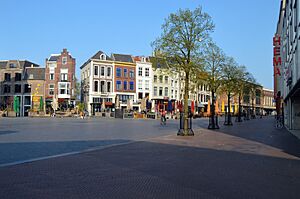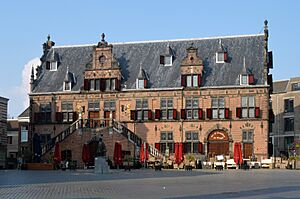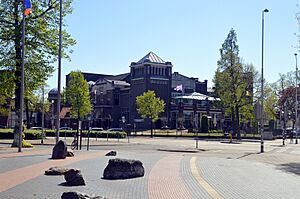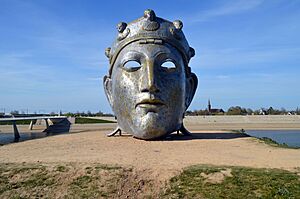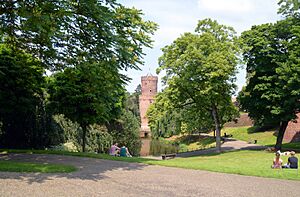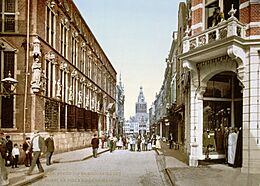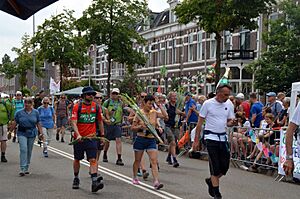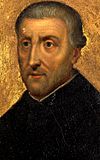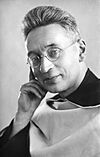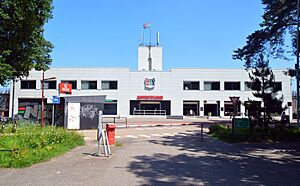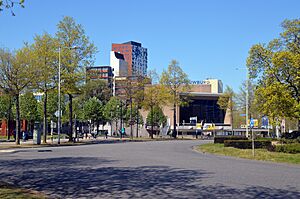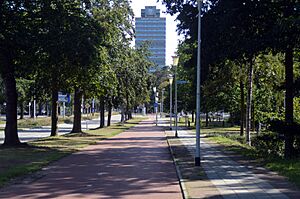Nijmegen facts for kids
Quick facts for kids
Nijmegen
Nimwèège (Nijmeegs)
|
|||||
|---|---|---|---|---|---|
|
City and municipality
|
|||||
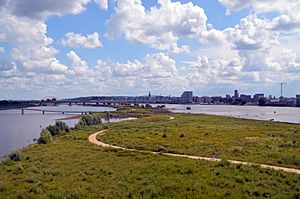
Nijmegen city view from the north-west
|
|||||
|
|||||

Location in Gelderland
|
|||||
| Country | |||||
| Province | |||||
| Founded | 98, as Novio Magus | ||||
| Founded by | Trajan | ||||
| Government | |||||
| • Body | Municipal council | ||||
| Area | |||||
| • Municipality | 57.60 km2 (22.24 sq mi) | ||||
| • Land | 53.62 km2 (20.70 sq mi) | ||||
| • Water | 3.98 km2 (1.54 sq mi) | ||||
| Elevation | 29 m (95 ft) | ||||
| Highest elevation | 88 m (289 ft) | ||||
| Lowest elevation | 7 m (23 ft) | ||||
| Population
(Municipality, May 2014; Urban and Metro, May 2014)
|
|||||
| • Municipality | 168,840 | ||||
| • Density | 3,149/km2 (8,160/sq mi) | ||||
| • Urban | 168,840 | ||||
| • Metro | 801.973 | ||||
| Demonym(s) | Nijmegenaar | ||||
| Time zone | UTC+1 (CET) | ||||
| • Summer (DST) | UTC+2 (CEST) | ||||
| Postcode |
6500–6547, 6679, 6683
|
||||
| Area code | 024, 0481 | ||||
| Click on the map for a fullscreen view | |||||
Nijmegen is a big city in the Netherlands. It's the largest city in the province of Gelderland and the tenth largest in the whole country. Nijmegen is located on the Waal River, which is close to the German border.
Nijmegen is one of the oldest cities in the Netherlands. It was the first Dutch city to be officially recognized by the Romans way back in ancient times. In 2005, the city celebrated its 2,000th birthday!
In 1230, Nijmegen became a special "free imperial city." This meant it had a lot of independence. Later, in 1402, it joined the Hanseatic League, a group of trading cities. Today, Nijmegen is also known as a university city. This is because Radboud University Nijmegen opened there in 1923. The city is also famous for its yearly walking event, the International Four Days Marches Nijmegen.
As of 2024, about 187,011 people live in Nijmegen.
Contents
Exploring Nijmegen's Areas
The city of Nijmegen includes the main city area and some smaller former villages. These include Hatert, Hees, and Neerbosch. There are also newer areas built north of the Waal River, like Veur-Lent.
Close to the German Border
Nijmegen is only a few kilometers from the border with Germany. Some people who work in Nijmegen actually live in nearby German villages. This is because houses can be cheaper just across the border.
The German city of Duisburg is about 78 kilometers away. The German town of Kleve is even closer, about 20 kilometers away.
A Look Back at Nijmegen's History
| Historical population | ||
|---|---|---|
| Year | Pop. | ±% p.a. |
| 1400 | 10,800 | — |
| 1500 | 12,000 | +0.11% |
| 1560 | 10,000 | −0.30% |
| 1611 | 11,780 | +0.32% |
| 1651 | 8,160 | −0.91% |
| 1741 | 12,000 | +0.43% |
| 1795 | 11,008 | −0.16% |
Ancient Times: Roman Beginnings
Nijmegen's story begins in the first century BCE. That's when the Romans built a military camp there. This spot was perfect because the hills offered a great view over the Waal River.
Around 69 CE, a village called Oppidum Batavorum grew near the Roman camp. This village was destroyed during a local revolt. But after the revolt, the Romans built an even bigger camp. A new village soon formed around this camp.
In 98 CE, Nijmegen became one of the first places in the Netherlands to get special Roman city rights. This was a big deal!
In 104 CE, Emperor Trajan gave the town a new name: Ulpia Noviomagus Batavorum. People often just called it Noviomagus. This is where the name Nijmegen comes from today.
In 2022, archaeologists found an amazing 2,000-year-old blue glass bowl in Nijmegen. It was perfectly preserved! This shows how skilled ancient craftspeople were.
Middle Ages: Trade and Art Flourish
After the Roman Empire weakened, Noviomagus became part of Francia. Trade grew thanks to the Waal River.
In 1230, Nijmegen was granted city rights by Emperor Frederick II. In 1247, the city became part of Guelders. This didn't stop trade, and Nijmegen even joined the Hanseatic League in 1364. This was a powerful group of trading cities.
During this time, art also thrived. Famous painters like the Limbourg brothers were born and trained in Nijmegen.
Early Modern Period: Challenges and Treaties
During the Dutch Revolt, trade slowed down. Even after Nijmegen became part of the Dutch Republic in 1591, it was a border town. This meant it faced many attacks.
In 1678, important talks happened in Nijmegen. These talks led to the Treaty of Nijmegen, which tried to end wars in Europe.
For a long time, the city walls were a problem. There were too many people inside, but the walls couldn't be removed. This changed in 1874 when the walls were finally taken down.
Nijmegen grew steadily in the late 1800s and early 1900s. The Radboud University Nijmegen was founded in 1923. A channel was dug in 1927 to connect the Waal and Meuse rivers.
Bridges were built over the Waal River. A rail bridge opened in 1878, and a road bridge in 1936. This road bridge was once said to be the biggest in Europe! In 2013, a second road bridge, called De Oversteek, was opened to help with traffic.
World War II: A Difficult Time
In 1940, Germany invaded the Netherlands, and Nijmegen was the first Dutch city to be taken. On February 22, 1944, American planes heavily bombed Nijmegen. This caused a lot of damage to the city center. It was later said to be an accident. Over 750 people lost their lives in the bombing.
In September 1944, there was fierce fighting in Nijmegen during Operation Market Garden. The goal was to stop the Germans from destroying the bridges. Capturing the road bridge was important for the Allies to reach Arnhem. The bridge was strongly defended by German troops. Nijmegen was freed from German control by British and American soldiers in September 1944. The city then became a starting point for the Allied invasion across the Rhine River.
After the War
After World War II, from 1946 to 1948, a camp near Nijmegen was used to house German people who were being sent out of the Netherlands.
In the 1980s, the city government wanted to build a parking garage. This led to protests from people who wanted affordable housing instead.
Nijmegen is often called the oldest city in the Netherlands. It celebrated its 2000th birthday in 2005.
Nijmegen's Climate and Nature
Weather in Nijmegen
Nijmegen has an oceanic climate, which means it has mild winters and cool summers. It's one of the warmer cities in the Netherlands, especially in summer. The highest temperatures in the country are often recorded in the area around Roermond, Nijmegen, and Eindhoven.
Some of the northernmost wineries in the world are found near Nijmegen, around the village of Groesbeek.
During a heat wave in 2006, temperatures in the city reached about 36°C. This heat wave happened during the annual Four Days Marches, which had to be cancelled after the first day.
| Climate data for Nijmegen, Netherlands (1971–2000) | |||||||||||||
|---|---|---|---|---|---|---|---|---|---|---|---|---|---|
| Month | Jan | Feb | Mar | Apr | May | Jun | Jul | Aug | Sep | Oct | Nov | Dec | Year |
| Record high °C (°F) | 15.0 (59.0) |
17.7 (63.9) |
23.0 (73.4) |
27.1 (80.8) |
31.9 (89.4) |
34.8 (94.6) |
36.7 (98.1) |
36.3 (97.3) |
31.0 (87.8) |
27.5 (81.5) |
18.4 (65.1) |
16.0 (60.8) |
36.7 (98.1) |
| Mean daily maximum °C (°F) | 5.2 (41.4) |
6.2 (43.2) |
9.8 (49.6) |
13.3 (55.9) |
18.1 (64.6) |
20.4 (68.7) |
22.6 (72.7) |
22.9 (73.2) |
19.0 (66.2) |
14.3 (57.7) |
8.9 (48.0) |
6.2 (43.2) |
13.9 (57.0) |
| Daily mean °C (°F) | 2.6 (36.7) |
2.9 (37.2) |
5.8 (42.4) |
8.4 (47.1) |
12.9 (55.2) |
15.5 (59.9) |
17.5 (63.5) |
17.3 (63.1) |
14.1 (57.4) |
10.2 (50.4) |
6.0 (42.8) |
3.8 (38.8) |
9.8 (49.6) |
| Mean daily minimum °C (°F) | −0.2 (31.6) |
−0.4 (31.3) |
1.7 (35.1) |
3.4 (38.1) |
7.4 (45.3) |
10.2 (50.4) |
12.2 (54.0) |
11.7 (53.1) |
9.4 (48.9) |
6.1 (43.0) |
2.8 (37.0) |
1.0 (33.8) |
5.4 (41.7) |
| Record low °C (°F) | −20.1 (−4.2) |
−15.3 (4.5) |
−13.7 (7.3) |
−7.4 (18.7) |
−1.7 (28.9) |
0.9 (33.6) |
3.8 (38.8) |
3.5 (38.3) |
−0.9 (30.4) |
−5.5 (22.1) |
−9.8 (14.4) |
−18.8 (−1.8) |
−20.1 (−4.2) |
| Average precipitation mm (inches) | 64.8 (2.55) |
42.7 (1.68) |
63.0 (2.48) |
44.4 (1.75) |
58.8 (2.31) |
74.3 (2.93) |
62.6 (2.46) |
56.2 (2.21) |
68.9 (2.71) |
66.2 (2.61) |
69.9 (2.75) |
72.3 (2.85) |
744.1 (29.30) |
| Average precipitation days | 22 | 17 | 21 | 18 | 17 | 18 | 17 | 17 | 18 | 19 | 21 | 22 | 227 |
| Average relative humidity (%) | 89 | 86 | 82 | 77 | 75 | 76 | 77 | 77 | 83 | 87 | 90 | 90 | 82 |
| Mean monthly sunshine hours | 47.4 | 74.1 | 105.7 | 151.7 | 193.5 | 172.5 | 183.1 | 182.9 | 127.4 | 102.8 | 55.8 | 40.0 | 1,436.9 |
| Source: Klimaatatlas van Nederland, normaalperiode 1971–2000, ISBN: 90-389-1191-2 | |||||||||||||
Historical Buildings and Sites
Not many very old buildings are left in Nijmegen. This is because of damage during World War II and later city planning. However, there are still some interesting sights.
- The Valkhof Museum has displays about Nijmegen's history, including Roman artifacts.
- On Valkhof hill, you can see part of a very old chapel from the 8th or 9th century. There's also a small piece left of an imperial castle.
- The 750-year-old Stevenskerk church had to be rebuilt after World War II.
- In 2022, ruins of a 3,600-year-old sauna were found. This is the first of its kind found in mainland Europe!
Who Lives in Nijmegen?
As of 2023, about 182,465 people live in Nijmegen.
| 2020 | Numbers | % |
|---|---|---|
| Dutch natives | 130,549 | 73.4% |
| Western migration background | 21,457 | 12% |
| Non-Western migration background | 25,653 | 14.4% |
| Turkey | 5,553 | 3.1% |
| Indonesia | 4,167 | 2.3% |
| Morocco | 3,930 | 2.2% |
| Netherlands Antilles and Aruba | 2,197 | 1.23% |
| Suriname | 1,590 | 0.89% |
| Total | 177,659 | 100% |
Culture and Events in Nijmegen
The Famous Four Days Marches
Since 1925, Nijmegen has hosted the yearly Four Days Marches. This event encourages sports and exercise. It starts on the third Tuesday of July. Over 40,000 people from about 70 countries take part. They walk distances from 30 to 50 kilometers each day for four days. There are also many fun parties and events during the Vierdaagse Festival.
Famous People from Nijmegen
Many interesting people were born or lived in Nijmegen:
- Henry VI, Holy Roman Emperor (1165–1197)
- Limbourg brothers (1385–1416), famous medieval painters
- Petrus Canisius (1521–1597), a Catholic saint
- Henriette Pressburg (1788–1863), mother of Karl Marx
- Alex Van Halen (born 1953), musician
- Eddie Van Halen (1955-2020), musician
- Princess Margarita of Bourbon-Parma (born 1972), a member of the Dutch royal family
- Amira Willighagen (born 2004), a classical singer
Sports in the City
Nijmegen is home to the football club NEC Nijmegen, often called NEC. They play at the 12,500-seat Stadion de Goffert. The club plays in the top Dutch football league, the Eredivisie.
The city also has one of the oldest cricket clubs in the country, Quick 1888. Nijmegen also hosts the yearly Zevenheuvelenloop (Seven Hills Run). This is a 15-kilometer race recognized by the IAAF.
Economy and Getting Around Nijmegen
Main Employers in Nijmegen
The three biggest employers in Nijmegen are:
- Radboud University
- The city's three hospitals: Radboud University Medical Center, Sint Maartenskliniek, and Canisius-Wilhelmina Ziekenhuis (CWZ).
- Companies that make computer chips and other electronic parts, like Nexperia and Ampleon.
Making Room for the River Waal
To prevent floods, the Dutch government is changing the course of many rivers. This project is called ‘Room for the River’. One part of this project is in Nijmegen. The Waal River has a sharp bend and can become very narrow here. This caused high water and floods in the past.
To protect the city, a new channel was dug next to the river. This created an island called Veur-Lent in 2015. This big project also included building three new bridges and dikes. The island now has a park where people can relax and enjoy nature.
Getting Around Nijmegen
Nijmegen has five train stations. The main station, Nijmegen Central Station, connects to the national train network. The bus company Breng runs city buses in the area.
Like most Dutch cities, bicycles are a very popular way to get around. There's even a "fietssnelweg" (fast cycle highway) that connects Nijmegen to Arnhem. In 2016, Nijmegen was named the "Cycling City" by the Dutch Cyclists' Union.
The Kaizer Karelplein is a large roundabout in the city center. It has seven busy roads connecting to it.
The Waal River is a busy route for cargo ships. They travel between German industrial areas and the ports in Amsterdam and Rotterdam. The Maas–Waal Canal also carries freight through the city.
Learning and Education in Nijmegen
Nijmegen is home to Radboud University Nijmegen. It was founded in 1923 as the first Catholic university in the Netherlands. As of 2018, it had over 22,000 students. The university has a special lab called the High Field Magnetic Laboratory. It can create very strong magnetic fields for scientific research.
The HAN University of Applied Sciences also has departments in Nijmegen. These include education, social work, and medical studies.
There are also many secondary schools in Nijmegen, like Kandinsky College and Stedelijk Gymnasium.
Nijmegen is also a key place for studying how language and the mind work. It's home to the Max Planck Institute of Psycholinguistics.
In 2010, the Nobel Prize for Physics was given to Andre Geim and Konstantin Novoselov. They did their amazing work on a material called graphene while at Radboud University.
See also
 In Spanish: Nimega para niños
In Spanish: Nimega para niños






